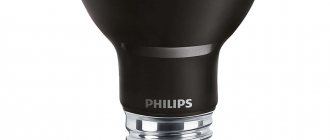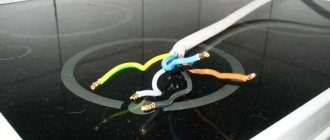When using LEDs as primary lighting sources, you may encounter such an urgent problem as periodic pulsation of light.
Why does the LED lamp blink when turned on? This is due to the peculiarity of the LED matrix, which, unlike an ordinary incandescent electric lamp, passes direct current only in one direction. The light from an ordinary incandescent filament also pulsates, but due to the fact that for such a lamp it does not matter in which direction the electrons move, the flickering frequency corresponds to the carrier frequency of the alternating current in the network (50 Hz) and is not visible to our eyes. In addition, due to the heating of the spiral, the amplitude of the pulsation of the light flux is insignificant.
An LED emits light only in a strictly defined direction of current, and an arbitrary change in voltage immediately causes a change in brightness.
Low frequency flashing
The alternating voltage in the network changes its amplitude in the form of a sinusoid with a frequency of 50 times per second. When passing through the LED, only a positive or negative half-wave will generate a glow in the matrix.
If the LED lamp blinks, you may have saved on the power supply. In the most budget models, a single-bridge (half-wave) rectifier is sometimes used, which converts alternating voltage to the required direct voltage.
After the diode bridge, part of the oscillations of the opposite phase is cut off, and to reduce ripple, a capacitor is included in the electrical circuit. With this scheme, we clearly see the pulsation of light with a frequency of twenty-five times per second.
If the LED lamp blinks when it is turned on and after installing a normal rectifier bridge in the power circuit, the problem is in the smoothing capacitor.
At maximum amplitude it accumulates charge, at minimum it returns it to the load. The average amplitude of the output voltage decreases, but the ripple becomes significantly less. If the capacity is insufficient, its resource is not enough to power the LEDs, the brightness of which changes with each half-wave. According to sanitary standards, the pulsation of the light flux should not exceed 10% of the nominal intensity.
How to get rid of blinking LED lamps in these cases?
Resoldering a diode rectifier bridge and a capacitor of larger capacity will help to make lighting without pulsation.
The third reason why light can pulsate even in the highest quality lamps is voltage drops in the network itself. Effective mains voltage 310V (nominal 220V). Often, especially in the evening, when residents turn on a powerful load, the voltage can drop to 190-180 V, which leads to the flickering of light sources.
Primary actions
When the light flashes when the light is off, the first thing to do is check the switch. If the connection was made by a novice master, then he could simply make a mistake. And instead of the phase, connect a neutral wire to the closing key. That is zero.
The test is very simple, and there is no need to call an electrician to carry it out. If there is an indicator screwdriver in the house, then any person, even those very far from working with electricity, can handle the situation on their own. True, you will have to disassemble the switch itself and get to the contacts. Therefore, if you are not confident in your abilities, then it is better to call a professional.
The keys at the switch are removed. Then use the tip of a screwdriver to touch the screw on the contact module. If the LED on the device lights up, then everything is fine with the connection. This indicates that a phase was used for contact.
When the screwdriver does not light up, you will have to make changes to the wiring. It is necessary to replace the neutral wire with the one that comes from the phase. When checking, you need to pay attention to the indicator screwdriver. Most of these devices have a special button to activate the LED. And without pressing it, the actions will be incomplete.
Voltage indicator Source zubr-russia.ru
Ideally, it is good to have a diagram of the electrical wiring in the house on hand for a complete comparison. Because it is advisable to check all switches on the line. They could also have the wires mixed up. Then the problem is solved by throwing lines on a common panel. If the error is only in one switch, then the replacement must be carried out in the distribution box.
Why do LED lamps from branded manufacturers blink?
At low voltage in the network, even with sufficient capacitor capacity, flickering may appear, since due to a decrease in amplitude the capacitor simply will not have time to recharge.
Such power surges are occasional, but if they cause discomfort, installing a voltage stabilizer can help.
If all the problems have been resolved, but the LED lamps still blink when turned on, check the contacts on the socket and switch. Perhaps the oxide film simply worsens the contact at the junction.
It is extremely rare that not the entire light bulb blinks, but only part of the LEDs . Why does the LED blink when neighboring crystals are shining normally? This problem occurs if several types of crystals with different power ratings were used when assembling the matrix. Unfortunately, it is not possible to fight this; most likely, some of the LEDs will soon simply fail.
The blinking of LED lamps with a low frequency, visible to the eye, is immediately detected and the only question is to find the cause.
Reasons for blinking when the lights are off
It often happens that after the light is turned off, the flickering of the lamp continues. This is not visible during the day, but at night faint flickering flashes become clearly visible. Why does the energy-saving lamp blink when the lights are off? This behavior of the device can occur for 3 reasons: a low-quality product, a bad backlit neon switch, or improper installation.
Malfunction and wiring problems
If the LED light flickers after turning off, the problem may be with the wiring. It is necessary to check how the phase cable is connected. The connection is considered correct when the phase passes through the switch and is not connected directly to the lamp. A diode indicator screwdriver will help you recognize the phase wire. Having distributed the wires correctly, the light bulb is once again checked for functionality. Blinking often occurs due to induced voltage. This is when the power wire is too close to the disconnected cable.
When working with wiring, you need:
- take into account its condition;
- follow safety precautions.
If the switch you are using does not have a night light, and the flickering continues, then it is better to completely replace the electrical wiring with a new one.
Illuminated switch
Illuminated switches are the most popular among consumers. The design is equipped with a neon lamp or a simple LED, which makes it easy to find the switch at night. But with the addition of a new part, the LED light began to flicker. This is due to the small charge that accumulates on the filter capacitor:
- when the switch is turned on, electricity goes directly to the lamp, and when turned off, it goes to the LED;
- Due to the flow of current, the filter begins to constantly charge, and the lamp flickers.
High frequency LED flicker
A more serious problem is the flickering of LED lamps when turned on at a frequency of 100 Hz (one hundred times per second). Our visual organs do not recognize such pulsation, but the brain is able to easily perceive vibrations with a maximum frequency of up to three hundred times per second.
Such a light installed in a hallway or bathroom will not cause problems. But reading or performing precise work in such lighting will cause increased fatigue, including headaches.
How to recognize such a pulsation if the eye does not see it? Take a ballpoint pen or a pencil and quickly wave it in front of the light bulb. If the pencil “breaks up” into separate fragments when moving quickly, there is pulsation.
Another way to establish such a pulsation is to look at the lamp through the built-in camera of a mobile phone.
The presence of dark stripes confirms high-frequency pulsation.
Briefly about the main thing
The blinking of the light when the power is off is directly related to a fault in the wiring. It happens that an error occurs when connecting the wires in the switch. And instead of the phase, the breaker was set to zero. If you swap the wires, the problem is solved.
But most often the light bulb flickers when using energy-saving lighting devices. When their switch is backlit. In this case, the problem can be solved either radically (removing the backlight unit) or by modifying the circuit. An additional resistor is soldered into it.
Why do LED lamps flicker when turned on?
The most likely reason is the relatively low quality of the LED matrix itself. Even with a “classical” power supply circuit, output voltage ripple is inevitable. High-quality LEDs in a certain voltage range have almost the same luminescence intensity, due to which any ripple is eliminated.
With “problematic” matrices, even a voltage drop of 0.5V already generates a noticeable change in brightness. In some cases, the current situation can be slightly improved by increasing the capacitor capacity, but it is still not recommended to install such light in living rooms.
If you detect a blinking LED lamp, do not leave everything to chance. In the worst case, it can cause vision problems over time. If possible, it is better to immediately return the light bulb to the seller. If this is not possible, take the time to eliminate all shortcomings.
Please rate the article. We tried our best:)
Did you like the article? Tell us about her! You will help us a lot :)
Warning!
But let us remember firmly: without the qualifications and skills of an electrician, without special tools and protective equipment, it is impossible to carry out work on ANY electrical equipment, including household electrical appliances! You can only use the standard controls without disassembling anything.
Electric shock will not warn you in advance, and its consequences are unpredictable and can be long-lasting. Especially if you have been drinking alcohol. Already from a shot of vodka, a person’s electrical resistance drops 1000 times, and an otherwise harmless pinch can turn out to be a fatal blow.
Independent search for the cause of the malfunction
If an energy-saving lamp used in a lamp or other product begins to blink, then you need to start fixing the problem immediately. Since each lighting device has resource limitations in terms of the number of starts.
That is, each such cycle reduces the operating time, and if they are repeated frequently, then in just a few days the service life will be reduced by many months, or even years. In addition, as mentioned above, if the wiring is faulty, there may be a threat to the health of the home owner, his family and friends, which should not be allowed.
Troubleshooting should only be carried out by a trained technician, using a special tool in compliance with all safety measures provided for in the governing documents. The troubleshooting procedure should begin with the simplest methods that do not require costs. And if they don’t give results, then move on to more complex ones.
So, first of all, you need to check the functionality of the light bulb itself. Why can it be moved to another place, tested with neighbors and acquaintances. If the blinking continues, then you just need to replace the lighting fixture. When, after installing the lamp in a new location, the malfunction does not appear, then the switch should be replaced. In order not to waste money, you can take it from another place for testing and, preferably, it should be without a backlight. When the cause is identified, you should simply buy and install a new switch.
If this does not produce results, then the owner of the premises should look for a problem in the wiring. But when performing any electrical work, it is important to remember that all of it is potentially dangerous. Therefore, you need to follow measures to prevent and avoid risky situations, have sufficient skills and have the appropriate tools.
The information in the following article will help you find out the reason why the LEDs glow after disconnecting from the power supply.
Reason 5 – high frequency interference
They are produced by some types of household appliances that generate radiation with a frequency of 2.4 GHz. This could be microwave ovens, cordless phones, satellite dishes, etc. As a rule, this is old-style equipment. In the presence of high-frequency interference, not only LED light bulbs react to them, but also other household appliances: the TV screen flashes, the speakers make noise. You can eliminate interference by installing special filters in the electrical network, which are sold in electrical equipment stores.
High-frequency interference can also affect the operation of energy-saving lamps
High quality energy saving lamps
When buying energy-saving lamps, make it a rule to pay attention to who the manufacturer is. There is no doubt about the quality of the lamps, from such a well-known manufacturer as Philips. These lamps have good characteristics:
- heat generation is insignificant;
- lasts a long time;
- saves energy by 80%;
- turns on without blinking;
- provides luminous flux of 85%.
Another leader in the production of lighting equipment is the German company Osram. This brand is very popular, and lamps from the OSRAM DULUX SUPERSTAR and OSRAM DULUXSTAR series are distinguished by:
- warm, pleasant light, like incandescent light;
- almost instantaneous achievement of the planned luminous flux;
- excellent light output;
- long service life - 15 thousand hours;
- compact attractive design.
How it works? Difference between different types of lamps
As you know, manufacturers produce several types of lamps. Until recently, the most famous and widespread were ordinary incandescent lamps. Such a lighting accessory emits light due to very strong incandescence, heating of a special wire inside a glass bulb. It is called the "filament".
There are also fluorescent and energy-saving light bulbs. There is no filament in such lighting fixtures. The operation of such lamps is carried out due to the formation of a potential difference. In this case, electrons flying inside the device in the gas cause it to glow.
Before we begin to understand why energy-saving light bulbs blink, let’s determine what conditions they have.
- There is no power to the lamp and it is turned off.
- There is a slight voltage coming to the light bulb. Sometimes it may be a small amount of current, too small to start it. In this case, the capacitor is gradually charged. When sufficient voltage accumulates, the light bulb turns on briefly. However, the capacitor is instantly discharged, and the device immediately goes out. This process looks as if an energy-saving light bulb is blinking.
- When sufficient power is supplied for normal operation of the lighting fixture, the light bulb turns on. The device serves to perform its main function - illumination of a room, objects, area, etc.
Now that you have become a little familiar with the principle of operation of energy-saving light bulbs, you can begin to understand why energy-saving light bulbs blink.
Operation of an energy-saving light bulb
Both fluorescent and energy-saving lamps have the same operating principle:
- A glow discharge occurs between two electrodes placed in a flask into which inert gas and mercury vapor are pumped.
- The invisible ultraviolet radiation of mercury atoms, while passing through the walls of the flask, coated on the inside with a phosphor, turns into the light that we see. At the same time, the color of the light is different, it all depends on what composition was used to coat the inside of the lamp.
Interesting: Despite the fact that the voltage in our networks is alternating, the energy-saving lamp operates at constant voltage. The conversion of DC to AC voltage occurs in an electronic ballast using a diode bridge.
What happens if you don't change a blinking light bulb?
If you are not annoyed by the constant flickering of lights in the room, here is another argument in favor of eliminating the problem as soon as possible. Back in the 60s of the last century, scientists proved the negative effect of light pulsation on the body. They analyzed the physiological and psychological state of schoolchildren studying in rooms with normal and flickering lighting. By the end of the day, children from the second group more often complained of dry eyes, headaches, and experienced an inexplicable loss of strength. After replacing the pulsating lamps with normal ones, the children got rid of the unpleasant sensations. So the flickering of light bulbs affects our health, even if we don’t notice it.
Malfunctions of energy-saving lamps
Let's look at what malfunctions of energy-saving lamps happen and how to eliminate them using the example of PHILIPS 6yr 23W ECONOMY.
Disassembling energy-saving lamps
We disassemble the housing of the energy-saving lamp in the following sequence:
- take a flat-head screwdriver and, moving carefully around the perimeter, push back the latches;
- disconnect the lamp cylinder by unscrewing the 4 wires with which it is connected to the electronic unit;
- We unsolder the wires connecting the base and the board. The block will remain in your hands. It is now possible to determine the fault.
Common faults:
- If there is increased voltage in the network, the capacitor will swell and leak, and the lamp will stop lighting. Here it is necessary to replace the CD and test all semiconductors.
- For the same reason, a malfunction such as breakdown of capacitor C5 occurs. The lamp glows only where the filaments are located. We change the capacitor.
- The reason for the incomplete glow of the lamp may be a rather long operation. In this case, the sealing of the flask is partially broken, and thermionic emission is reduced. We throw away the lamp.
- When one of the filaments burns out, the lamp stops burning. In this case, we check the serviceability of capacitor C5. Where the filament is broken, we unsolder the diode, and in its place we insert a 10 Ohm resistor.
- Another reason for the failure of an energy-saving lamp is a faulty diode thyristor (dinistor). This reason is detected by eliminating the malfunction of semiconductors, capacitors, inductor windings, and filaments. The solution is to replace the faulty element.
- If, by calling resistors and semiconductors, you see that they are out of order, then the parts, of course, must be replaced. But think about whether it’s worth doing this, because such repairs will be expensive. It's easier to buy a new lamp.
Watch how the author of this video eliminates the flickering of an energy-saving lamp:
Option 3 (global): The light flashes throughout the entire apartment
- Let's say there is at least one room in the apartment where the light does not blink . Then, most likely, the problem is in the “dose” - the distribution box inside the apartment. There is no need to go there yourself, but your information may be useful to an electrician.
- Flashes “the whole apartment? “We look out the windows. If it also blinks in neighboring houses, there is a fault at the substation or in the main supply cable - feeder. You need to inform the emergency utility service or directly to the power grid dispatcher - the number will be given at the help desk.
- Do the lights in neighboring houses burn smoothly? Let's look into the entrance - how is it there, is it blinking? Let's ask the neighbors. Is it flashing at everyone’s entrance? The feeder from the substation to the house is faulty, or the equipment of the input switchboard in the house or the electrical distribution network in it. Here you definitely need to inform the municipal emergency department - house electrical networks are under their jurisdiction.
- Finally, is it only yours that is blinking? Perhaps the fuse (plug) of your apartment in the electrical panel on the staircase is faulty. If it is available and there is a spare, you can replace it. But! If the shield is sealed, DO NOT OPEN it under any circumstances! There will be problems and sanctions with the energy sector later. And for the same reason – plus fire and electrical safety – DO NOT INSTALL A “BUG” CORK with a homemade wire fuse. A fire caused by a bug is a very common situation.











